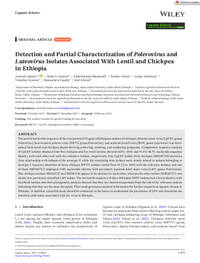Detection and Partial Characterization of Polerovirus and Luteovirus Isolates Associated With Lentil and Chickpea in Ethiopia

Authors:
The partial nucleotide sequence of the coat protein (CP) gene of Ethiopian isolates of chickpea chlorotic stunt virus (CpCSV, genus Polerovirus), beet western yellows virus (BWYV, genus Polerovirus), and soybean dwarf virus (SbDV, genus Luteovirus) was determined from lentil and chickpea plants showing yellowing, stunting, and reddening symptoms. Comparative sequence analysis of CpCSV isolates obtained from five chickpea and five lentil isolates showed 94.9%–100% and 91.9%–98.7% nucleotide sequence identity with each other and with the reference isolates, respectively. One CpCSV isolate from chickpea (MZ043728) showed a close relationship with isolates of the serotype II while the remaining nine isolates were closely related to isolates belonging to serotype I. Sequence identities of three chickpea BWYV isolates varied from 93.3% to 100% with the reference isolates, and one of them (MZ043727) displayed 100% nucleotide identity with previously reported lentil stunt virus (LStV, genus Polerovirus). The chickpea isolates MZ043725 and MZ043726 appear to be identical to each other, whereas the other isolate (MZ043727) was identical to previously identified LStV isolate. The nucleotide sequence of three Ethiopian SbDV isolates had a lower identity with GenBank isolates and their phylogenetic analysis showed that they are clustered separately from the rest of the reference isolates indicating that they are the most divergent. This result generates essential information for further research on legume viruses in Ethiopia. In addition, a detailed study should be conducted in the future to understand the prevalence of LStV and determine the potential yield losses associated with the virus in Ethiopia.
